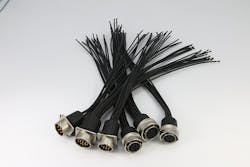Rugged and harsh environments can wreak havoc on electrical systems and their connectors—vibration, temperature extremes, chemicals, and other fluids can (and will) render those systems useless if their connections become compromised. Nearly every industry has some form of environment that’s detrimental to sophisticated electronic systems, and because they’re the entry point to those systems, connectors are on the front lines.
(Image credit: Pixabay)
Harsh-environment connectors are designed to withstand volatile environments and have undergone rigorous testing before deployment, giving engineers and end-users increased confidence.
Applications in mining are subjected to dust, shock, and vibration; offshore oil rigs and other marine services have to deal with saltwater corrosiveness; and aerospace applications routinely undergo extreme temperature and pressure fluctuations. As a result, connectors have been designed to withstand those environments and maintain their integrity.
To help defend connectors against hazardous operating conditions, manufacturers have added new features in their designs, which include durable contacts, rugged metal or thermoplastic shells, watertight seals, and various locking mechanisms.
This metal high-voltage power connector features a spring-loaded internal locking mechanism and protective plastic end caps. (Source: Pixabay)
Rugged metal casings and thermoplastic shells need to be manufactured from quality materials to withstand years of exposure to harsh environments. Metal housings must be able to stand up against repeated shock, vibration and sudden impact, while thermoplastic needs to be engineered to defend against chemicals/fluids and temperature extremes. Depending on the application, these can come in many different forms, including rectangular and cylindrical body shapes, and feature secure locking systems to keep them mated.
Shells and casings can be manufactured using a variety of materials to meet the requirements of their operating environment. Common metals range from aluminum and stainless steel to brass and titanium, while thermoplastics and composites include nylon and glass-filled polymers such as PEEK, PEI, and PPS.
Fluid-resistant seals are critical for operation in harsh environments, as they help mitigate any intrusion from dust, chemicals, and water. Silicone seals and grommets need to function flawlessly to provide a maximum seal to outside contamination. They must also retain their flexibility across a wide range of temperature extremes without degradation.
Contact alignment is another crucial element for electrical connectors intended for rugged environments. Locking mechanisms that snap onto or into the mating surface help to ensure the internal contacts slide together perfectly when mated, with some producing an audible click when successfully engaged. These include threaded coupling rings, push-latches, lever locks, and jackscrews that clamp the connector and surface together. Many connectors are also outfitted with wedge locks and TPAs (terminal position assurance) that offer additional keying options and further connection stability with both the contact barrel and mating surface.
Internal contacts or pins represent another vital aspect of harsh environment connectors. If the flow of signal or power becomes disrupted, then the electrical equipment and applications will fail. Contacts often consist of different metals that resist corrosion and offer superior power and signal transmission, with one to form the shape and the other for plating. They come in a wide range of metals; however, copper forms and nickel plating are the most common.
The MIL-DTL-38999 nickel plated polymer connector is designed for use in rugged environments. (Source: Abaillieul via Wikipedia)
Harsh and rugged connectors are manufactured under strict regulations that must adhere to industry standards, which falls under the International Protection Marking or IP Code delegated by the International Electrotechnical Commision (IEC). The codes feature a pair of digits to signify robust particle protection and liquid ingress protection. Therefore, an IP rating of IP67 designates the connector is entirely secure against solid debris and can be submerged in fluid up to one meter in depth.
The European Union has gone beyond the IP rating system to include the ATEX directive, which outlines protections against explosions in the working environments. Connectors must be designed and tested to ensure no electrical arcing or sparking can happen in volatile situations where flammable gases, vapors, and other explosive materials are present. The directive offers a similar number system as IP codes, but is broken down into six zones ranging from 0 (places where flammable gas, vapors, and mist are continuously present) to Zone 22 (places where explosive dust may be present for short periods of time).
Harsh-environment connectors are designed with engineers in mind, meaning they’re as easy to use and service in the field as they are on the manufacturing floor. This helps reduce the training and service time in the field. At the same time, it aids in lowering the costs associated with equipment servicing and training processes, thereby improving efficiency.
Choosing the right connectors is paramount when operating in harsh environments such as this sea-based oil rig. (Source: Jim Hatter via Wikipedia)
When choosing the right connector, careful consideration of the environment is mandatory. Asking the right questions can help determine the optimal connector. Some of the questions engineers should be asking include:
What kind of terminations and types are necessary?
Are there size or space constraints?
Is sealing needed for protection against water or other fluids?
Is the connector for signal or electrical purposes?
Although the selection criteria are extensive and can quickly become confusing, most manufacturers offer services to guide you through the myriad options to pinpoint the most efficient connector design.





